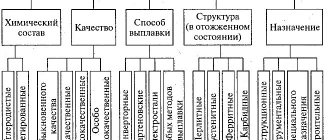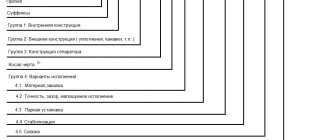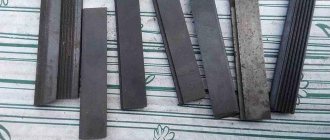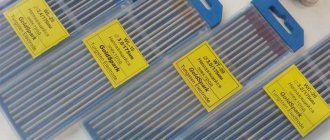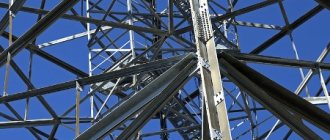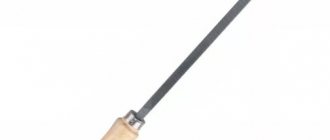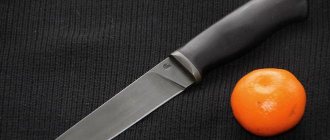02/26/2021 Author: VT-METALL
Issues discussed in the material:
- Tasks of marking metal products
- Mechanical marking of metal products
- Electrochemical method of metal marking
- Laser marking of metal products
- Nuances of metal marking for the domestic market
- Other methods of marking metal products
Methods for marking metal products are designed not only to provide products with the necessary information in accordance with the law, but also to facilitate the production process itself. It is almost impossible to distinguish one type of metal from another by eye. In addition, it becomes easier to keep track of released products, track batches and work with customers.
There are quite a few methods for marking metal, the choice of which depends on the material itself and the production method, as well as storage and operating conditions. In our article we will tell you how the marking process is carried out, what technologies are used and what its main tasks are.
Marking of metal products
Almost no modern production can do without labeling its products. The need for it is explained not only by legal requirements (often quite strict), but also by ease of operation. This applies to metal even more than to many other products, since it is sometimes almost impossible to distinguish one or another grade of steel by eye. In addition, applying information to your own products makes it easier to keep records at the enterprise. In our article today we will tell you how to place the necessary data on metal products. And let’s dwell a little more on the laser technology of their application.
Printing and marking technology
This option implies a certain symbiosis, since it combines the advantages of printed products and a traditional labeler. In practice, this means that the necessary information is first applied to a roll of special material, which is subsequently glued directly onto the packaging of a particular product.
Among industry experts, such systems are well known as printer-applicators. Two types of “self-adhesive” are used as roll material: regular and with a silicone backing. Both options are good in their own way, which is why both options are in high demand in industrial systems. This type of marking and packaging equipment is also advantageous due to the fact that it can be integrated into ready-made packaging systems on a modular basis.
Also among the advantages is the fact that combined devices allow you to perform really high-quality printing and stick it to the packaging as tightly as possible due to high-quality roll tension and the presence of special clamping devices.
In general, each of the systems mentioned above is distinguished primarily by a high level of performance, since it is designed for use on an industrial scale. Due to this, the quality of products truly meets high standards, and the cost of the entire range of work is significantly reduced.
Metal marking functions
1. Informational. This is its main function. Thanks to the data printed on it, the consumer can understand what material the product is made of and what properties it has.
2. Identification. Allows you to recognize a specific product and distinguish it from others.
3. Emotional and motivational. Beautiful labeling can serve as an additional incentive to purchase the product. In turn, carelessly or illegibly printed data can make the buyer wonder whether he should contact this manufacturer.
Technologies and methods of data application
There are 2 application methods - direct and additional.
In the case of the latter, the information is placed on a tag, label, sticker or some other item that is attached to the product. This method is not popular in the metallurgical industry because tags and labels can easily come off or get mixed up during transportation. The main method of application is direct. That is, placement directly on the product. Let's consider several technologies for such marking.
1. Thermal transfer printing. For this method, special thermal transfer tapes are used, the paint layer from which is transferred to the metal under the influence of high temperature. The method is not very popular due to the large amount of consumables and lower marking reliability compared to other technologies.
2. Impact-point. Using a needle-impact printer, a large number of dots are printed on the surface of the product. This method easily applies both alphanumeric information and 2D barcodes, which are later read using a DPM code scanner.
Such marking is very popular among many manufacturers, since it does not require a large amount of consumables (the service life of one tungsten-carbide punch is several million blows) and is very wear-resistant. A paint layer is even applied over the markings without compromising the readability of the information.
3. Electrochemical. Data is applied on a stencil under the influence of an electric current charge. As a result of the reaction, the color or even the surface topography changes, forming the necessary letters and numbers.
4. Stamping (branding). It is carried out using a pre-made stamp on a mechanical press, which makes an impression with the necessary information. The standard set of stamps includes letters and numbers. From a technological point of view, this is the most cost-effective and simplest method.
5. Drop jet. Contactless method of applying data. It is often used in cases where the product is small in size and other data application technologies can deform it. Information is applied with drops of ink.
6. Drawing. It is carried out using a needle pressed tightly to the surface of the metal, which draws grooves on its surface. The technology is used as an alternative to dot-impact marking. The needle deforms the surface to a lesser extent and produces noticeably less noise during operation.
Electric spark pencil
Today you can find several names: electric pencil, electric spark pen, electric marker.
Electric spark pencil
Using an electric marker, inscriptions are applied to a smooth metal surface.
This method is chosen in cases where the impact-point method is not suitable, stamps are inconvenient, laser application is too expensive or impractical.
The marking pencil is mainly used for metal components and parts where bulging of the surface due to the marking is not allowed.
It is often used as a means of adjusting and correcting markings on a flat or relatively flat metal surface. The type and alloy of the metal may be different.
Laser marking of metal. Advantages and disadvantages
Laser technology is the most advanced and reliable method of applying information to metal.
This marking has an indefinite lifespan since it is not subject to any physical or chemical influences. It can be applied to any alloy without any additional conditions. In addition, a clear advantage of laser technology is its high speed of operation, which does not affect the level of operation of the enterprise. It does not require large energy consumption, does not require consumables and allows you to apply the necessary information even in hard-to-reach places that are inaccessible to other marking methods. All that is needed to implement it is a computer with a data transmission and control system and a laser itself. The only disadvantage of laser marking is the heating of the surface during the marking process. Before sending the product to the warehouse after applying the data, you have to wait for some time until it cools down.
Marking is a necessary element in any industry
Today, markings are used everywhere. They are used on various types of industrial equipment and tools. Marking is needed because it is a kind of code that tells about the composition of the metal and its quality. Marking is an alphanumeric designation applied to any part of the metal surface.
Metal markings can be of two types:
The first type is an informative marker.
The second type is identification
In order for the marking to be durable and of high quality, it must be applied only with professional equipment, which is selected individually for each metal. Smart Marking company offers a wide range of marking equipment at affordable prices and manufactured to all standards.
Marking of metals by etching. Acid markers MARKAL
Existing methods (technologies) for industrial marking of finished products made of metals and alloys can be divided into two groups (hanging tags are not considered):
A. Not affecting the marked product (so-called “non-intrusive”):
- paint marking – hand-held markers based on solid or liquid paint, inkjet printers;
- self-adhesive labels on paper or polymer base.
B. Changing properties of the surface of the marked product (so-called “intrusive”):
- chemical etching;
- electrochemical etching;
- hand branding;
- automated dot-impact marking;
- laser marking.
Lettering methods
Branding methods can be different:
- Mechanical
- Chemical
- Electrical
- Photochemical
- Electrochemical
How to choose a labeling method? Usually the designer makes a choice by comparing some product parameters. Namely: product configuration, size, material, surface hardness, production volume, aesthetic requirements, the nature of the marking applied, its constancy, the degree of mechanization and automation of production.
Existing methods of product labeling.
There are currently a huge variety of ways to label products.
The purpose of labeling is to accompany the product with the necessary service information, for example, the name of the product or serial number, or date of manufacture, catalog number, code, etc.
Sometimes markings are combined with packaging or labeling, or the necessary information is placed directly on the product constructively - for example, by casting the main technical characteristics of the device directly on the body, or by printing a bar code on the packaging. However, this can only be done if the labeling requirements remain unchanged for a long time, for example, a constant barcode of the product. But even in this case, it is often easier and cheaper to resort to another method of marking, as, for example, in the case of casting a case - the mold wears out, and engraving significantly increases its cost, against this background it is much more convenient and economical to press a few keys and spend less one kopeck for ink.
Let’s make a reservation right away – we are not talking about colorful labels or packaging here. Only methods of marking goods with official information are considered.
Products can be marked in automatic, semi-automatic and manual modes.
Checklist: what is needed to implement a labeling system
- EDI
It is better to study this topic now in order to decide on an operator and discuss with him options for establishing business processes in the company and connecting contractors.
- New equipment that can work with marking codes
Since the Data Matrix code will be applied to the product packaging, it is necessary to have equipment that can read this code. For example, a 1D scanner will not cope with this task.
If you work with tobacco and use weak 2D scanners, then be prepared for the fact that such scanners will also not be able to read the Data Matrix code. Therefore, pay attention to equipment suppliers and their capabilities.
- Cash register and cash register software
Pay attention to what cash register and cash register software you have installed: can they now work with labeled goods? Check with your supplier about this.
- Connection to OFD
Make sure that the fiscal data operator knows how to interact with the CRPT and transmit the necessary information.
- Accounting systems
Analyze their condition and capabilities. If you are still using the old self-written system, then you need to worry about the issue of storing and accounting for marking codes.
- IT solution for transferring information to Honest Sign
You need to decide which solution you will use: develop your own or use what is offered by specialized IT companies.
While businesses have time to join pilot projects, see how the labeling system works in their industry, and solve existing problems.
Product labeling methods
Product labeling is the application of special marks to its surface (or packaging) that carry information about the product: manufacturer, batch or batch number, production date and expiration date, and, if necessary, composition or technical characteristics. The modern consumer necessarily pays attention to the labeling of the purchased product: from it he judges its authenticity, quality, and ultimately makes a decision to purchase or to look for another, more suitable option. Thus, clear, legible and reliable labeling of the finished product is important, including from the point of view of competent marketing. One way or another, the presence of markings on the product is mandatory and is regulated by GOST standards.
The Electronic Business Systems company offers reliable equipment for various types of marking of finished goods, with high productivity. Our specialists will select the best solution for your business, based on many years of experience in this field.
Requirements for product labeling:
- the applied image must be contrasting and easy to read for the consumer;
- signs must be resistant to abrasion, i.e. remain on the surface or packaging, at least until the product is put into use;
- the marking (if it is not applied to the product itself, but is attached to it in the form of a tag, control tape, hanging label, etc.) must clearly relate to the product to which it belongs;
- information printed on finished products must be comprehensive and contain all the information on the product necessary for the consumer.
Labels for marking rolled metal products
Labels must be firmly attached and easily visible. The material used for manufacturing is reliable and wear-resistant, so that during transportation and unloading they are not damaged or come off. Sometimes, for safety, labels are placed in special pockets.
When packing rolled metal into bundles, markings are placed in 2 places:
- the top sheet or strip of each bundle;
- marking card or label attached to the pack's binding.
When auto-marking thick and strip metal products, the side edge of the top sheet or strip of each bundle can be branded. On the sheets, the marking area is outlined using paint, bitumen or colored varnish. If the customer so requests, the markings are highlighted in a contrasting color, and the labels are perforated 10 mm from the edge for fastening with wire on all types of metal products.
Marking of rolled products in packs or without packaging if the size exceeds 3 cm and thickness exceeds 4 mm must contain:
- Name of the company;
- steel grade;
- Heat number;
- Batch number;
- all sizes.
The marking on the label, the end of the roll or the edge of the metal sheet contains the company name, steel grade, heat number, batch number, all sizes, group or strength class, weight. For reliability and clarity of marking, the label can be metal, wood, plastic or moisture-resistant film; their area must be at least 24 cm2, and the letters must have a height of 5-20 mm and a width of 3-12 mm.
Sometimes it is allowed to deviate from the specified font size when marking with paint. It can reach 1 m in height and 7 cm in width; on rods with a diameter of less than 6 cm and strips with a width of less than 5 cm it can be reduced to 2-4 mm.
The consumer may request additional marking with colored paint; for rolled metal made of mild steel, marking with a longitudinal stripe; for rolled metal made of mild steel, a transverse stripe; marking can occur at a specified font depth. Transport marking is regulated by GOST 14192.
Product labeling: varieties
Let's take a closer look at what methods of applying information about a product exist.
- Mechanical markings: can be applied by embossing, die-cutting, perforating, engraving or stamping. This method is quite expensive in terms of wear and tear on the equipment used. In addition, it is contact, which means there is a possibility of damage to individual products or entire batches (for example, due to incorrectly applied perforation). Not all product groups are suitable for identification in this way.
- Thermal effects (melting and burning). The advantages and disadvantages of this method are similar to the previous one: the application technology itself is quite simple, but this does not exclude the high cost of operation and rapid wear of the equipment, as well as the difficulty in setting up programs (for example, if it is necessary to change the signs being applied).
- Thermal transfer printing (or thermal transfer). As a rule, in this way information is applied not to the product itself, but to its packaging, containers or other accompanying materials. Thermal transfer is an imprint of an ink ribbon. The advantages of this method lie in the wide variety of information applied: in this way, you can apply not only alphanumeric characters, but also a barcode, manufacturer data and many other information important to the consumer. However, product identification using thermal transfer also has its disadvantages, which include the high cost of consumables (ink ribbon), which directly affects the final cost of the finished product.
- Droplet identification. This is the method we offer to most clients, since it is universal and suitable for almost any group of goods. The advantages of inkjet printing include:
- high application speed, which means increased productivity;
- minimal cost of the operation in comparison with other methods of transferring information;
- lack of direct contact with the finished product, which eliminates its damage;
- ease of program reconfiguration and full automation;
- slow wear of the equipment used and its reliability.
The only disadvantage of this method is that it is not entirely suitable for goods with a very long shelf life, since over time the applied marks may become less clear or erased (for example, a piston or other metal products may need to be marked differently way, since it may be important for the consumer many years and even decades later - when repairing or replacing a part).
- Laser. In this case, information is applied to goods under the influence of a powerful beam. It is this method of applying identifying information that is used in cases where it is necessary to guarantee the virtually eternal presence of identification features on the surface of the product. Its disadvantages include low image contrast, as well as high operating costs, since quite expensive equipment is used.
Mechanical marking technologies
general information
Mechanical marking technologically combines a set of methods for applying information to surfaces through the influence of various mechanical devices.
The creation of clear and deep, well-readable recesses—impressions of a given shape—is produced as a result of mechanical impact, pressure or rolling on the marking elements, either manually or with the help of devices.
Technologically, the branding process is carried out using the following equipment:
- by impact using stamps, punches and numbering heads in special presses with different impact forces;
- rolling onto spherical surfaces using rolling machines.
The mechanical marking method is most relevant when applying information that does not change constantly and does not include a large number of characters.
Stamps and typesetting marks
With the help of “traditionally widespread”, inexpensive and simple marking with impact stamps and punches, also called branding, it is possible to apply short digital, alphabetic and symbolic series of information in the form of imprints on almost any type of material.
To make it easier to type a certain number of characters into an inscription, brand holders are used, which can be of several types depending on the method of application and fastening of the punches (ordinary, ring, conical and thermal).
Numbering heads
If there is a need to frequently change the set of applied characters, it will be productive to use special numbering heads, on the rotating planes of which a sufficient number of numbers, letters and symbols are placed. Such devices are used with impact or knurling machines, less often in manual applications. Numbering heads are available with manual, semi-automatic and automatic character change.
Percussion press
The most universal and accessible way of marking in flexible production of both piece and serial products will definitely be the use of embossing technology using mechanical presses.
These devices with adjustable impact force guarantee high productivity and quality of work, not only for marking tasks, but also for riveting, assembly or punching.
Mechanical presses , with their inherent fail-safe operating principle, provide:
- - high speed
- - permanent, non-removable clear inscriptions
- — work with surfaces without additional processing, of any shape (concave, convex) and hardness
- — effectiveness on products made of any materials
- — possibility of hot-rolled stamping
Knurling machines
In the case of problems associated with cylindrical products, the optimal solution would be to use special rolling machines (rolling machines), produced by the marking process with stacked rows of punches or numbering heads.
Choosing a branding method
Considering the principle of operation of marking devices and machines, manual branding will be optimal where production versatility is required, and there is a need to mark a small number of manufactured products or apply marks to parts and raw materials.
In serial or exclusive production, mechanical presses and rolling machines are effectively used for circular marking of rolled pipes.
Integrated pneumatic impact devices
Convenient use in production lines. Installation is possible at an angle, horizontally or vertically.
Combined pneumatic impact presses
Operates in manual and pneumatic modes. High performance, excellent print quality.
Manual impact presses
Adjustable impact force of the manual drive mechanism. Used with ready-made cliches or a set of stamps in a holder.
Impact mechanisms
Deep permanent visual marking of metal, plastic, wood with signs and symbols. Varies depending on the force of the impact.
Numbering heads
For marking infrequently changing information manually and using equipment. The choice of symbols and signs is individual.
Stamps and holders
Durable marking elements for marking symbols, letters and numbers, secured in a row with punches in a holder.

